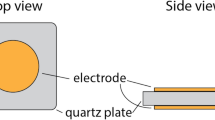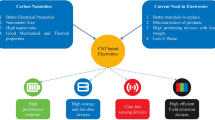Abstract
The development of miniaturized chemical sensors is an increasingly active area of research. Such devices, particularly when they feature low mass and low power budgets, can impact a broad range of applications including industrial process monitoring, building security and extraterrestrial exploration. Nanostructured materials, because of their high surface area, can provide critical enhancements in the performance of chemical microsensors. We have worked to integrate nanomaterial films with MEMS (microelectromechanical systems) microhotplate platforms developed at the National Institute of Standards and Technology in order to gain the benefits of both the materials and the platforms in high-performance chemical sensor arrays. Here, we describe our success in overcoming the challenges of integration and the benefits that we have achieved with regard to the critical sensor performance characteristics of sensor response, speed, stability and selectivity. Nanostructured metal oxide sensing films were locally deposited onto microhotplates via chemical vapor deposition and microcapillary pipetting, and conductive polymer nanoparticle films were deposited via electrophoretic patterning. All films were characterized by scanning electron microscopy and evaluated as conductometric gas sensors.
Similar content being viewed by others
References
Afridi M., Hefner A., Berning D., Ellenwood C., Varma A., Jacob B., Semancik S., (2004). MEMS-based embedded sensor virtual components for system-on-a-chip (SoC). Solid-State Electron. 48: 1777–1781
Barsan N., Weimar U., (2002). Conduction Model of Metal Oxide Gas Sensors. J. Electroceram. 7: 143–167
Benkstein K.D., Kopidakis N., van de Lagemaat J., Frank A.J., (2003). Influence of the Percolation Network Geometry on Electron Transport in Dye-Sensitized Titanium Dioxide Solar Cells. J. Phys. Chem. B 107: 7759–7767
Benkstein K.D., Montgomery C.B., Vaudin M.D., Semancik S., (2005a). The Development and Evaluation of TiO2 Nanoparticle Films for Conductometric Gas Sensing on MEMS Microhotplate Platforms. Mater. Res. Soc. Symp. Proc. 828: A.7.1–A.7.4
Benkstein K.D. & S. Semancik, 2005. Mesoporous nanoparticle TiO2 thin films for conductometric gas sensing on microhotplate platforms. Sens. Actuators, B (In press)
Boger Z., Meier D.C., Cavicchi R.E., Semancik S., (2003a). Rapid Identification of Chemical Warfare Agents by Artificial Neural Network Pruning of Temperature-Programmed Microsensor Databases. Sensor Lett. 1: 86–92
Boger Z., R.E. Cavicchi & S. Semancik, 2003b. Analysis of conductometric micro-sensor responses in a 36-sensor array by artificial neural networks modeling. Olfaction and Electronic Nose (Arcane Editrice S.r.l., Rome), 135–140
Caruso F., Caruso R.A., Mohwal H., (1998). Nanoengineering of Inorganic Hybrid Hollow Spheres by Colloidal Templating. Science 282(5391): 1111–1114
Caruso F., Lichtenfel H., Giersi M., Mohwal H., (1998). Electrostatic Self-Assembly of Silica Nanoparticle-Polyelectrolyte Multilayers on Polystyrene Latex Particles. J. Am. Chem. Soc. 120: 8523–8524
Cavicchi R.E., Walton R.M., Aquino-Class M., Allen J.D., Panchapakesan B., (2001). Spin-on nanoparticle tin oxide for microhotplate gas sensors. Sens. Actuators, B 77: 145–154
Cavicchi R.E., Semancik S., DiMeo Jr F., Taylor C.J., (2003). Use of Microhotplates in the Controlled Growth and Characterization of Metal Oxides for Chemical Sensing. J. Electroceram. 9: 155–164
Comini E., Guidi V., Frigeri C., Ricco G., Sberveglieri G., (2001). CO sensing properties of titanium and iron oxide nanosized thin films. Sens. Actuators, B 77: 16–21
Garcia-Belmonte G., Kytin V., Dittrich T., Bisquert J., (2003). Effect of humidity on the ac conductivity of nanoporous TiO2. J. Appl. Phys. 94(8): 5261–5264
Hoel A., Ederth J., Kopniczky J., Heszler P., Kish L.B., Olsson E., Granqvist C.G., (2002). Conduction invasion noise in nanoparticle WO3/Au thin-film devices for gas sensing application. Smart Mater. Struct. 11: 640–644
Huber B., Gnaser H., Ziegler C., (2003). Characterization of nanocrystalline anatase TiO2 thin films. Anal. Bioanal. Chem. 375(7): 917–923
Izu N., Shin W., Murayama N., (2003). Fast response of resistive-type oxygen gas sensors based on nano-sized ceria powder. Sensors and Actuators B 93: 449–453
James D., Scott S. M., Ali Z., O’Hare W.T., (2005). Chemical Sensors for Electronic Nose Systems. Microchim. Acta 149(1–2): 1–17
Kang M.G., Park N.-G., Park Y.J., Ryu K.S., Chang S.H., (2003). Manufacturing method for transparent electric windows using dye-sensitized TiO2 solar cells. Sol. Energ. Mat. Sol. C. 75(3–4): 475–479
Li G., Josowicz M., Janata J., (2002). Electrochemical assembly of conducting polymer films on an insulating surface. Electrochem. Solid-State Lett. 5(4): D5–D8
Li G., Martinez C., Semancik S., Smith J.A., Josowicz M., Janata J., (2004). Effect of Morphology on the Response of Polyaniline-based Conductometric Gas Sensors: Nanofibers vs. Thin Films. Electrochem. Solid-State Lett. 7(10): H44–H47
Li, G., C. Martinez, Semancik S., (2005). Controlled electrophoretic patterning of polyaniline from a colloidal suspension. J. Am. Chem. Soc. 127(13): 4903–4909
Martinez C. J., B. Hockey, C.B. Montgomery & S. Semancik, 2005. Porous tin oxide nanostructured microspheres for sensor applications. Langmuir 21(17), 7937–7944
Nartowski A.M., Atkinson A., (2003). Sol-Gel Synthesis of Sub-Micron Titanium-Doped Chromia Powders for Gas Sensing. J. Sol-Gel Sci. Tech. 26(1–3): 793–797
Panchapakesan B., DeVoe D.L., Widmaier M.R., Cavicchi R., Semancik S., (2001). Nanoparticle engineering and control of tin oxide microstructures for chemical microsensor applications. Nanotechnology 12: 336–349
Park C.O., Akbar S.A., (2003). Ceramics for chemical sensing. J. Mat. Sci. 38: 4611–4637
Persaud K., Dodd G., (1982). Analysis of discrimination mechanisms in the mammalian olfactory system using a model nose. Nature 299(5881): 352–355
Ruiz A.M., Dezanneau G., Arbiol J., Cornet A., Morante J.R., (2004). Insights into the Structural and Chemical Modifications of Nb Additive on TiO2 Nanoparticles. Chem. Mater. 16: 862–871
Safonova O., Bezverkhy I., Fabrichnyi P., Rumyantseva M., Gaskov A., (2002). Mechanism of sensing CO in nitrogen by nanocrystalline SnO2 and SnO2(Pd) studied by Mössbauer spectroscopy and conductance measurements. J. Mater. Chem. 12(4): 1174–1178
Savage N.O., Roberson S., Gillen G., Tarlov M.J., Semancik S., (2003). Thermolithographic Patterning of Sol-Gel Metal Oxides on Micro Hot Plate Sensing Arrays Using Organosilanes. Anal. Chem. 75: 4360–4367
Semancik S., Cavicchi R.E., (1998). Kinetically Controlled Chemical Sensing Using Micromachined Structures. Acc. Chem. Res. 31: 279–287
Semancik, S., Cavicchi R.E., Wheeler M.C., Tiffany J.E., Poirier G.E., Walton R.M., Suehle J.S., Panchapakesan B., DeVoe D.L., (2001). Microhotplate platforms for chemical sensor research. Sens. Actuators, B 77: 579–591
Semancik S., (2003). In: Xiang X.-D. & Takeuchi I. eds. Combinatorial Materials Synthesis. Marcel Dekker, Inc., New York, NY
Soulantica K., Erades L., Sauvan M., Senocq F., Maisonnat A., Chaudret B., (2003). Synthesis of Indium and Indium Oxide Nanoparticles from Indium Cyclopentadienyl Precursor and Their Application for Gas Sensing. Adv. Funct. Mater. 13(7): 553–557
Suehle J.S., Cavicchi R.E., Gaitan M., Semancik S., (1993). Tin Oxide Gas Sensor Fabricated Using CMOS Micro-Hotplates and In-Situ Processing. IEEE Electron Device Lett. 14(3): 118–120
Taylor C.J., Semancik S., (2002). Use of Microhotplate Arrays as Microdeposition Substrates for Materials Exploration. Chem. Mater. 14: 1671–1677
Traversa E., Di Vona M.L., Licoccia S., Sacerdoti M., Carotta M.C., Crema L., Martinelli G., (2001). Sol-Gel Processed TiO2-Based Nano-Sized Powders for Use in Thick-Film Gas Sensors for Atmospheric Pollutant Monitoring. J. Sol-Gel Sci. Tech. 22: 167–179
Wang S.-H., Chou T.-C., Liu C.-C., (2003). Nano-crystalline tungsten oxide NO2 sensor. Sensors and Actuators B 94: 343–351
Zaban A., Ferrere S., Sprague J., Gregg B.A., (1997). pH-Dependent Redox Potential Induced in a Sensitizing Dye by Adsorption onto TiO2. J. Phys. Chem. B 101: 55–57
Acknowledgements
This work was partially supported by NASA Code R. We would like to thank Richard Cavicchi for useful discussions, Mike Carrier for device design work and Jim Melvin for technical assistance.
Author information
Authors and Affiliations
Corresponding author
Additional information
The U.S. Government’s right to retain a non-exclusive royalty-free license in and to any copyright is acknowledged.
Rights and permissions
About this article
Cite this article
Benkstein, K.D., Martinez, C.J., Li, G. et al. Integration of nanostructured materials with MEMS microhotplate platforms to enhance chemical sensor performance. J Nanopart Res 8, 809–822 (2006). https://doi.org/10.1007/s11051-005-9019-8
Received:
Accepted:
Published:
Issue Date:
DOI: https://doi.org/10.1007/s11051-005-9019-8




